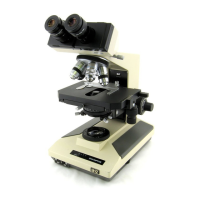OlympusBH‐2(BHT/BHTU)Electronics Revision2 Page5of24
FilteredDCPowerSupply
DiodeD201andcapacitorC201operate asapeak detector to produce filteredDCpower from thefull‐wave‐rectified
output ofbridge rectifier DB101.This filtered DC power line supplies powerto the comparators and their respective
LEDs.TheACripplepresent on this line depends on the amountof
currentpulled by thecomparators and LEDs.At
minimalcommandedlampintensity(i.e.,withallfourLEDsintheoffstate),verylittlecurrentisrequiredandthevoltage
on this line is approximately +10.5V with little AC ripple.As the lamp intensity is increased (and the LEDs begin to
successivelyilluminate), thecurrentdrain on this line increases as doestheresulting AC ripple.When the lamp is at
maximumintensity,allfourLEDsareilluminatedandtheACrippleisatitsmaximum,resultinginanaveragevoltageon
thefilteredDCpowersupplylineofapproximately+9.5V.Figure
25showstheripplevoltageonthefilteredDCpower
supply line withthe equipment operating under worst‐case ripple condi tions of maximum lamp intensity.The green
traceisthepositiveoutputofbridgerectifierDB101andthebluetraceisthefilteredDCpowersupplyline.
ComparatorThresholds
The switching thresholds of the four op‐amp comparators are provided by a four‐stage voltage divider consisting of
resistorsR208,R209,R210,R211,andR212.Thesethresholdsareconfiguredtoallowthecomparators toilluminatethe
LEDsatpre‐definedlampvoltagesof2V,4V,6V,and7V,inresponse
tothedecreasingcontrolsignalfromtheintensity
potentiometer.Figure 26showsthe threshold voltages ontheinvertingpinsofthe op‐ampcomparators.Thegreen
traceisthepositiveoutputofbridgerectifierDB101,fromwhichthefourthresholdvoltagesarederived.Theblue,red,
cyan, and magenta traces
are the threshold voltages on the inverting inputs of IC1‐A, IC1‐D, IC1‐B, and IC1‐C,
respectively.
Control‐SignalClamp
ResistorsR213andR214,anddiodesD202,D203,andD204,clampthevoltageleveloftheintensity controlsignalfrom
potentiometer RV101 to keep the non‐inverting inputs of the comparators from ever dropping below approximately
+0.7V.This is necessary to prevent the LEDs from illuminating briefly during the intervals where
bo th the wiper of
potentiometerRV101andthecomparatorthresholdsdroptozeroatthezerocrossingsoftheACline.Ifbothinputsto
thecomparatorswereallowedtosimultaneouslydroptozero,thecomparatorswouldbeinanindeterminatestate, and
depending ontheinput‐offset voltage parameters
ofthe specificop‐amp devices, their outputs couldpulllow during
theseintervals,resultinginoneormoreLEDsnotfullyextinguishingwhentheyshould.
The operation of the control‐signal clamp is as follows.Resistor R214 feeds a DC current through the two series‐
connected silicon diodes, D203 and
D204, producing a potential on the anode of diode D204 two diode drops above
ground(approximately+1.4V).TheanodeofdiodeD202connectstothis+1.4Vnodeanditscathodeconnectstothe
non‐invertinginputsofthefourcomparators.ResistorR213couplesthecontrolsignalfrompotentiometerRV101to
the
non‐inverting inputs of the comparators.Any time the control signal is low enough to forward bias diode D202, the
voltageonthenon‐invertinginputsofthecomparatorsisclampedtoapproximately+0.7V(i.e.,onediodedroplessthan
+1.4V).AsthevoltageonthewiperofRV101increases,
diodeD202turnsoffandis effectivelyoutofthecircuit,thereby
providing no further clamping action.This mechanism allows the intensity control signal to swing positive without
restraint, but prevents it from dropping below approximately +0.7V.Figure 27 shows the waveform of the clamped
controlsignalatthe50%
settingoftheintensitycontrol,asmeasuredatthenon‐invertinginputsofthecomparators.
VoltageComparators
Integrated circuit IC1 is a NEC uPC324Cquad operation amplifier.All four sectionsof IC1 are operated open‐loop as
voltagecomparatorsandareconfiguredtodrivethefourbar‐graphLEDsinresponsetotheclampedcontrol signalfrom
potentiometer RV101.Each comparator illuminates its associated LED by driving its
output low during the intervals
wheretheclampedcontrolsignaldropsbelowitsthresholdvoltage,andextinguishesitsLEDbydrivingitsoutputhigh
duringtheintervalswheretheclampedcontrolsignalexceedsitsthresholdvoltage.Figure28showstheoperatio nof
oneofthecomparators(IC1‐B)withthe
6VLEDilluminated.Inthesewaveforms,theintensitycontrolissettothe70%
setting.ThegreenwaveformisthethresholdvoltagepresentontheinvertingpinofIC1‐B,andthebluewaveformisthe
clamped control signal on the non‐inv erting pin of IC1‐B.During the intervals where
the control signal is below the
thresholdvoltage,thecomparatoroutputpulls low,illuminatingthe6VLED,andduringtheintervalswherethecontrol
signal is clamped to approximately +0.7V (and is exceeding the threshold voltage), the comparator output pulls high,

